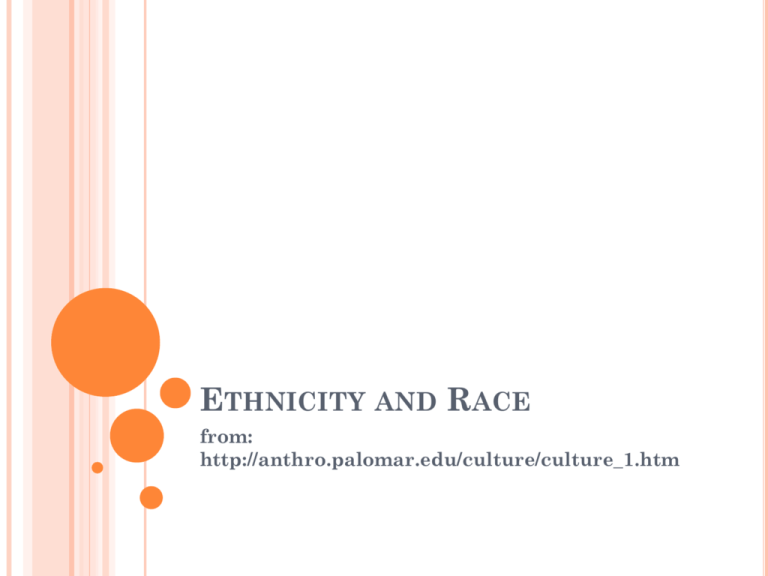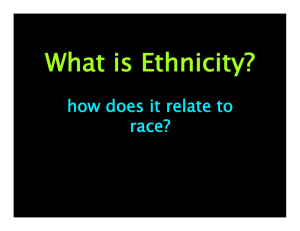Ethnicity and Race
advertisement

ETHNICITY AND RACE from: http://anthro.palomar.edu/culture/culture_1.htm OVERVIEW What race are you? How do you define your race? What does it mean to be Black or White or Asian or Hispanic? Ethnicity: refers to selected cultural and sometimes physical characteristics used to classify people into groups or categories considered to be significantly different from others. E.g.: First Nations, Latinos, Chinese-Canadians, AfroCanadians Sometimes ethnicity involves loose group identity with little cultural traditions in common (Irish and German Canadians) and sometimes this may include groups that are coherent subcultures with a shared language and body of tradition Minority and ethnic group are different Ethnic groups may be the minority or the majority In small homogeneous societies like those of hunter-gatherers and pastoralists there is usually only one ethnic group and no minorities Some erroneously think that ethnicity implies a connection between biological inheritance and culture and that biological inheritance determines much of cultural identity We know that this is not true and that race and culture are not the same thing Edward Tylor: Cultural traits are entirely learned and any baby can be enculturated to that culture A race is meant to be a biological subspecies consisting of more or less a distinct population with anatomical traits that distinguish it clearly from other races. However, this does not fit the reality of human variation In fact, humans are 99.9% genetically identical and most variation is between males and females and unique personal traits This homogeneity is unusual e.g: chimpanzees have 2-3 times more genetic variation than people and orangutans have 8 – 10 times more variation Race is a cultural creation and not a biological reality This comes from the misconception that anatomical traits like skin colour and facial characteristics cluster together into single distinct groups of people Anatomical traits supposedly identifying a particular race are often found extensively in other population as well This is due to the fact that similar selection factors in different parts of the world often result in the evolution of similar adaptations E.g.: intense sunlight in tropical areas as selected for darker skin color as a protection from intense ultraviolet radiation E,g: dark skin of sub-Saharan Africans is also found among unrelated populations in the Indian subcontinent, Australia and New Guinea and other places in the Southwest Pacific We could all be classified into a number of different races depending on the traits that are emphasized E.g.: if we used blood type to qualify race B type would cluster Australian Aborigines with most Native Americans and some Africans would be the same race as Europeans which others would be classified with Asians Ethnicity like race is a cultural and historical construct THE NATURE OF ETHNICITY Ethnic symbols are badges of identity to emphasize distinctness from other groups Language, religion and style of dress are common ethnic symbols Sometimes biological characteristics may be important as well E.g: African American ethnicity is usually defined by dark brown skin, but shared experience and dialect are often as important since the range of skin coloration is quite broad among African Americans Ethnic group unity is reinforced by constant emphasis on what traits set the members apart from others, rather than what they share in common with the outsiders This is a universal means of boundary maintenance , or defence between ethnic groups Ethnic symbols are convenient markers for making “wethey” distinctions and focal points for racism and manifestations of ethnocentrism They also mask in-group differences and lump groups together Individuals in minority ethnic groups may wish to assimilate into the dominant ethnic group and choose de-emphasize their ethnic symbols E.g.: children of immigrants may speak their colloquial dialect of English rather than their parents’ native language Assimilation may be speeded up by marriage across ethnic boundaries The effect of intermarriage on reducing ethnic group identity can be seen in the reduction of discrimination against varying European groups in North America After several generations E.g.: discrimination against Jews in North America as reduced in conjunction with the increase in marriage to nonJews In 1960s only 6% of American Jews married outsiders, in 1985 25%, in the mid 1990s 52% African Americans have had a low frequency of intermarriage In 1970 2.6% of their marriages were to European Americans, in 1993 12.1%, rate for men has been 3.5x higher than women Asian and Latin Americans have had a high intermarriage rate 12% of men and 25% of women intermarried This may indicate a low resistance to assimilation in their communities and a greater acceptance of them by the dominant European American society FORMS OF DISCRIMINATION Prejudice and discrimination are universal Can range from benign classification of people to cruel persecution Kwame Appiah, a scholar of African American issues has made a distinction between different types of prejudicial behaviour Racialism: benign categorizing people for reference purposes on the basis of age gender and ethnicity/race Everyone engages in racialism It’s normal to categorize based on traits or characteristics E.g.: lost in a strange city you are likely to approach and adult rather than a young child because you think an adult will know more Racism: harmful discrimination E.g.: not hiring someone because of their race Many groups think and act in a racist manner Even members of groups that are aggressively discriminated against by others may express racist attitudes Racism is expressed differently in small-scale and large-scale societies Small societies are usually biologically and culturally homogenous without ethnic group distinctions The target of racism is other societies and strangers are thought of as not being quite human Large societies are often heterogeneous and have many ethnic groups The targets of racism are mostly other ethnic groups within the same society E.g.: Northern Italians look down on Southern Italians and vice versa ETHNIC IDENTIFICATION PROCESS Ethnic identity can be self-identified or come from the outside Imposing ethnicity upon people has been a political tool for controlling and marginalizing them E.g.: Nazis labeling Jews even though the individuals they labeled as such didn’t identify with as Jewish 19th and early 20th century America restricted legal rights for people defined as being African, Asian, or Native American In Japan today 2nd and 3rd generation resident Koreans living in Japan have limited rights if they retain their Korean citizenship (Japan doesn’t allow dual citizenship) People in political and economic power usually define their own ethic group as being superior E.g.: portrayal of ‘whites’ and ‘non-whites’ in media Whether one has a positive or negative positive self-image that stems from ethnicity, gender or physical condition has a powerful effect on the way one relates to others and leads his or her life






